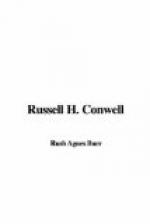For cleaning the church, a vacuum plant has been installed, which sucks out every particle of dust and dirt. It does the work quickly and thoroughly, in fact, so thoroughly it is impossible even with the hardest beating to raise any dust on the covered chairs after they have been cleaned by this process. Such crowds throng The Temple that some quick, thorough method of cleaning it became imperative.
Back of the auditorium on the street floor are the business offices of the church, Mr. Conwell’s study, the office of his secretary and of the associate pastor. All are practically and cheerfully furnished, fitted with desks, filing cabinets, telephones, speaking tubes, everything to carry forward the business of the church in a time-saving, businesslike way.
The acoustics of the great auditorium are perfect. There is no building on this continent with an equal capacity which enables the preacher to speak and the hearers to listen with such perfect comfort. The weakest voice is carried to the farthest auditor. Lecturers who have tested the acoustic properties of halls in every state in the Union speak with praise and pleasure of The Temple, which makes the delivery of an oration to three thousand people as easy, so far as vocal effort is concerned, as a parlor conversation.
Telephonic communication has recently been installed between the auditorium and the Samaritan Hospital. Patients in their beds can hear the sermons preached from The Temple pulpit and the music of the Sunday services.
Compared with other assembly rooms in this country, the auditorium of The Temple is a model. It seats thirty-one hundred and thirty-five persons. The American Academy of Music, Philadelphia, seats twenty-nine hundred; the Academy of Music, Brooklyn, twenty-four hundred and thirty-three; Academy in New York, twenty-four hundred and thirty-three; the Grand Opera House, Cincinnati, twenty-two hundred and fifty; and the Music Hall, Boston, twenty-five hundred and eighty-five.
But greater than the building is the spirit that pervades it. The moment one enters the vast auditorium with its crimson chairs, its cheery carpet, its softly tinted walls, one feels at home. Light filters in through rich windows, in memory of some member gone before, some class or organization. Back of the pulpit stands the organ, its rich pipes rising almost to the roof. Everywhere is rich, subdued coloring, not ostentatious, but cheery, homelike.
Large as is the seating capacity of The Temple, when it was opened it could not accommodate the crowds that thronged to it. Almost from the first, overflow meetings were held in the Lower Temple, that none need be turned away from the House of God. From five hundred to two thousand people crowded these Sunday evenings in addition to the large audience in the main auditorium above.
The Temple workers had come to busy days and large opportunities. But they took them humbly with a full sense of their responsibility, with prayer in their hearts that they might meet them worthily. Their leader knew the perils of success and with wise counsel guided them against its insidious dangers.




